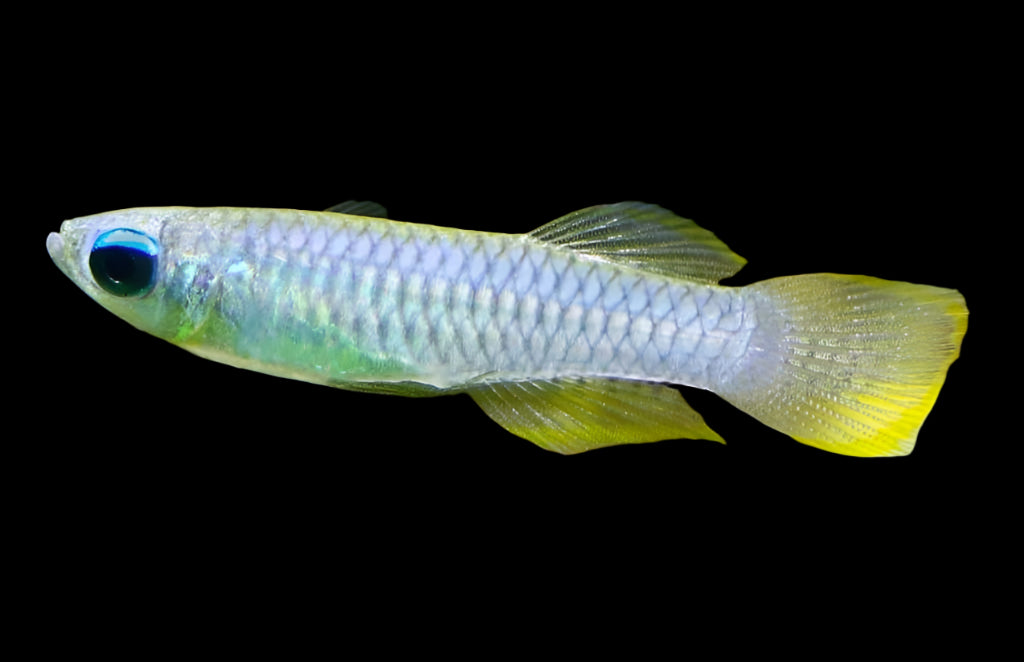Description
Norman’s Lampeye – A Subtle Sparkle for Your Freshwater Aquarium
(Poropanchax normani)
Delicate, peaceful, and beautifully understated, the Norman’s Lampeye (Poropanchax normani) is a graceful addition to any freshwater aquarium. Named for the striking, glowing blue "lamp-like" eyes that shimmer under light, these small schooling fish are perfect for planted tanks and community setups. Their gentle nature and constant movement bring harmony and charm to any aquascape.
Key Features:
-
Iridescent Eye Glow: The signature feature of Norman’s Lampeye is its bright, reflective blue eyes that gleam like tiny lights—especially stunning under overhead or natural lighting.
-
Peaceful Schooling Behavior: These fish thrive in groups of 6 or more, where they feel most secure and display their best natural behaviors, swimming in tight, graceful schools.
-
Subtle Body Coloration: While their bodies are translucent to pale silver, their elegant movements and luminous eyes make them a captivating presence in any tank.
-
Perfect for Nano & Planted Tanks: Their small size (maxing out around 1.2 inches) and peaceful disposition make them ideal for nano aquariums, especially those with dense plant cover and gentle flow.
Tank Compatibility:
-
Freshwater Aquariums
-
Ideal for community tanks with other peaceful, small species
-
Tankmates: Small tetras, rasboras, shrimp, pygmy corydoras, and peaceful killifish
Care Requirements:
-
Temperature: 72°F–78°F
-
pH: 6.0–7.5
-
Soft to moderately hard water
-
Provide plenty of live plants, floating vegetation, and subdued lighting to replicate their natural West African habitats.
-
A secure lid is recommended, as they can jump.
Feeding Tips:
-
Norman’s Lampeye will accept a wide range of foods: high-quality micro-pellets, flakes, and live or frozen foods like baby brine shrimp and daphnia.
-
Feed small portions frequently to ensure all fish get their share in a busy school.
Why Choose Norman’s Lampeye?
If you’re looking to add subtle elegance and shimmering life to your aquarium, Norman’s Lampeye (Poropanchax normani) is an excellent choice. Their glowing eyes, peaceful nature, and tight schooling behavior make them a unique and calming presence—perfect for aquascapes that balance beauty and tranquility.
Click & Collect
Livestock will only be bagged once you arrive, or if you contact us in advance to request it ready beforehand.
Local Delivery
Order anything from our in-store range and have it delivered right to you.
-
Minimum spend: £50
-
Delivery up to 10 miles: £10
-
Delivery up to 25 miles: £20
Distances are measured “as the crow flies”, not by road.
Once your order is placed, we’ll be in touch to arrange a suitable delivery date and time.
Please note, delivery may take a little longer as we often group orders together to build an efficient delivery run.
Important: If you’re ordering a large aquarium, please ensure someone is available to help unload the van on arrival.
Dry Goods Delivery
-
DX Express: 1 working day, same-day dispatch before noon 0-75kg
-
Express Pallet: 1–3 working days 75-500kg
If you'd like to add more items to an existing order that hasn't yet been dispatched, please place a Click & Collect order and leave a note asking us to combine the orders.
Please note: We currently only dispatch parcels Wednesday to Friday.
Pre-Order
Want the full details? Check out our Terms & Conditions.
Livestock Delivery
Thursday Delivery – £24
-
Dispatched Wednesday afternoon
-
Delivered Thursday before 1pm
-
Order by Wednesday 12 noon
-
Minimum spend: £50
Friday Delivery – £24
-
Dispatched Thursday afternoon
-
Delivered Friday before 1pm
-
Order by Thursday 12 noon
-
Minimum spend: £50
Saturday Delivery – £29
-
Dispatched Friday afternoon
-
Delivered Saturday before 1pm
-
Order by Friday 12 noon
-
Minimum spend: £50
📦 Want to Add to an Existing Order?
No problem! Just place a Click & Collect order and leave a note asking us to link it with your original one (as long as it hasn’t been dispatched yet).
🛒 Dry Goods Now Included!
You can now include dry goods in your livestock delivery – perfect for topping up supplies in one go.
❄️ Please note: We can’t send frozen food with livestock – please order frozen items separately.
⚠️ Delivery Exclusions
Unfortunately, we’re unable to deliver livestock to the following postcodes:
Scotland & Isles:
AB30–AB56, DD8–DD10, DG3–DG9, DG12–DG14, FK17–FK21, KA18–KA19, KA26–KA30, PA20–PA38, PA80, PH3–PH40
Cornwall Isles: TR21–TR25
All of the following postcodes are excluded:
BT, HS, IM, IV, JE, KW
Plus Channel Islands and Shetland Islands
Payment & Security
Your payment information is processed securely. We do not store credit card details nor have access to your credit card information.


